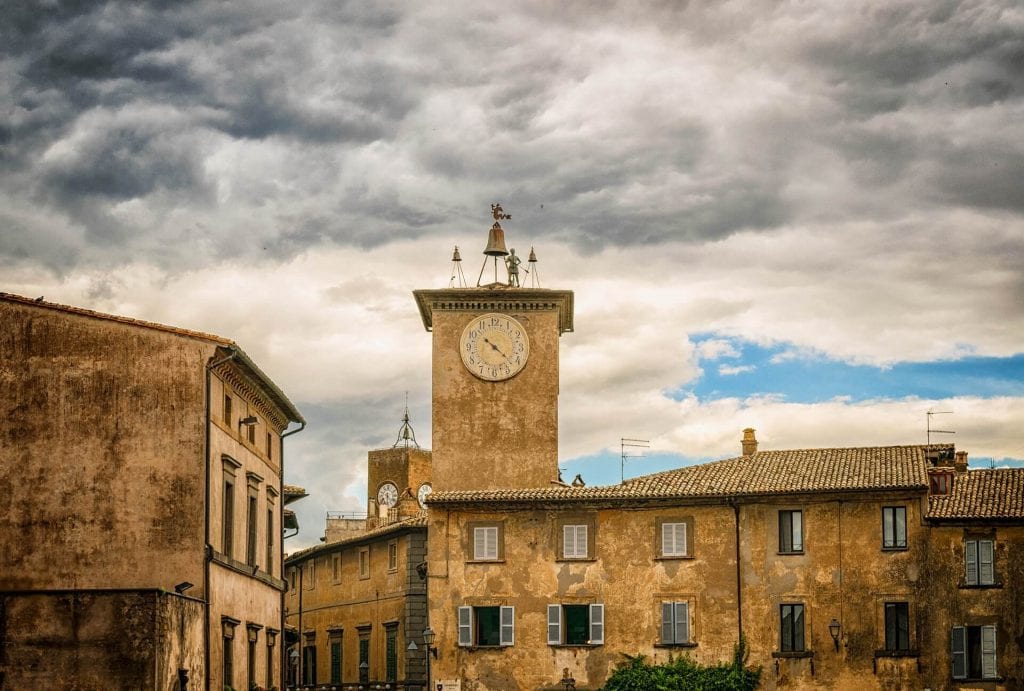Orvieto – a major centre of Etruscan civilization
Orvieto is a city and in the Province of Terni, southwestern Umbria, Italy situated on the flat summit of a large butte of volcanic tuff – the city rises above the almost-vertical faces of tuff cliffs that are completed by defensive walls built of the same stone.
Orvieto was certainly a major centre of Etruscan civilization; the archaeological museum (Museo Claudio Faina e Museo Civico) houses some of the Etruscan artifacts that have been recovered in the immediate area.
Orvieto was annexed by Rome in the third century BC. Because of its site on a high, steep bluff of tuff, the city was virtually impregnable. After the collapse of the Roman Empire its defensible site gained new importance: the episcopal seat was transferred from Bolsena, and the city was held by Goths and by Lombards before its self-governing commune was established in the tenth century, in which consuls governed under a feudal oath of fealty to the bishop.
Orvieto’s relationship to the papacy has been a close one; by the thirteenth century, three papal palaces had been built.
The territory of Orvieto was under papal control long before it was officially added to the Papal States; it remained a papal possession until 1860, when it was annexed to unified Italy.
The city of Orvieto has long kept the secret of its labyrinth of caves and tunnels that lie beneath the surface. Dug deep into the tuff, these secret hidden tunnels are now open to view only through guided tours. Their spectacular nature has also yielded many historical and archeological finds.
The underground city boasts more than 1200 tunnels, galleries, wells, stairs, quarries, cellars, unexpected passageways, cisterns, superimposed rooms with numerous small square niches for pigeon roosts, detailing its creation over the centuries.
Many of the homes of noble families were equipped with a means of escape from the elevated city during times of siege through secret escape tunnels carved from the soft rock. The tunnels would lead from the city palazzo to emerge at a safe exit point some distance away from city walls.
The Duomo

On 15 November 1290, Pope Nicholas IV laid the cornerstone for the present building and dedicated it to the Assumption of the Virgin, a feast for which the city had a long history of special devotion.
The church is striped in white travertine and greenish-black basalt in narrow bands, similar in many ways to the cathedral of Siena and other central Italian cathedrals of that era. In the following decade, cathedral authorities called Sienese architect and sculptor Lorenzo Maitani to stabilize the building and design a façade. He enlarged the choir and planned a transept with two chapels (c. 1308-1330), spaces that were not finished until long after his death. The Cathedral has five bells, tuned in E flat, which date back to the renaissance.
St. Patrick’s Well
The Pozzo di San Patrizio (“St. Patrick’s Well“) is a historic well built by architect-engineer Antonio da Sangallo the Younger of Florence, between 1527 and 1537, at the behest of Pope Clement VII who had taken refuge at Orvieto during the sack of Rome in 1527 by the Holy Roman Emperor Charles V, and feared that the city’s water supply would be insufficient in the event of a siege. The well was completed in 1537 during the papacy of Pope Paul III.
The name was inspired by medieval legends that St. Patrick’s Purgatory in Ireland gave access down to Purgatory, indicating something very deep.
The architect-engineer Antonio da Sangallo the Younger surrounded the central well shaft with two helical ramps in a double helix, accessed by two doors, which allowed mules to carry empty and full water vessels separately in downward and upward directions without obstruction. The cylindrical well is 53.15 metres (174.4 ft) deep with a base diameter of 13 metres (43 ft). There are 248 steps and 70 windows provide illumination.
